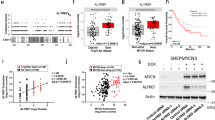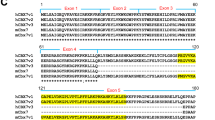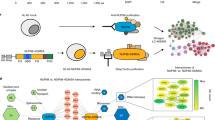Abstract
γ-Heregulin was identified as an isoform resulting from alternate splicing of the neuregulin-1 gene, after cloning of its cDNA from the MDA-MB-175 breast cancer cell line. γ-Heregulin was shown to promote growth of cultured MDA-MB-175 cells resulting from activation of its cognate ErbB tyrosine kinase reporters. We show here that γ-heregulin is transcribed from a fusion gene resulting from a chromosome translocation in MDA-MB-175 cells. The fusion chromosome is described as dic(8:11)(8qter→8p12::11q13→11pter). As a result, the 5′ end of the γ-heregulin gene is derived from the stress-induced gene, DOC-4 (11q13), while the 3′ end is from the neuregulin-1 gene (8p12). Thus, expression of γ-heregulin is under the control of the DOC-4 promoter. By contrast with MDA-MB-175 cells, RT – PCR failed to detect a γ-heregulin transcript in either E9.5 to E13.5 embryonic mouse tissues, adult mouse tissues or other human tumour cell lines. We conclude, therefore, that γ-heregulin is not a native isoform of the neuregulin-1 gene, but a novel growth factor that may contribute to tumour cell proliferation.
This is a preview of subscription content, access via your institution
Access options
Subscribe to this journal
Receive 50 print issues and online access
$259.00 per year
only $5.18 per issue
Buy this article
- Purchase on Springer Link
- Instant access to full article PDF
Prices may be subject to local taxes which are calculated during checkout



Similar content being viewed by others
References
Callen DF, Baker E, Eyre HJ, Chernos JE, Bell JA and Sutherland GR. . 1990 Ann. Genet. 33: 219–221.
Chausovsky A, Tsarfaty I, Kam Z, Yarden Y, Geiger B and Bershadsky AD. . 1998 Mol. Biol. Cell. 9: 3195–3320.
Gassmann M, Casagranda F, Orioli D, Simon H, Lai C, Klein R and Lemke G. . 1995 Nature 378: 390–394.
Grimm S and Leder P. . 1997 J. Exp. Med. 185: 1137–1142.
Ho WH, Armanini MP, Nuijens A, Phillips HS and Osheroff PL. . 1995 J. Biol. Chem. 270: 14523–14532,
Holmes WE, Sliwkowski MX, Akita RW, Henzel WJ, Lee J, Park JW, Yansura D, Abadi N, Raab H, Lewis GD, Shepard HM, Kuang W, Wood WI, goeddel DV and Vandlen RL. . 1992 Science 256: 1205–1201.
Lee KF, Simon H, Chen H, Bates B, Hung MC and Hauser C. . 1995 Nature 378: 394–398.
Liu X, Whang H, Cao L, Buchland M, Cunningham A, Chen J, Chien KR, Graham RM and Zhou M. . 1998a Proc. Natl. Acad. Sci. USA 95: 13024–13029.
Liu X, Whang H, Cao L, Wen D, Liu N, Graham RM and Zhou M. . 1998b J. Biol. Chem. 18: 34335–34340.
Marchionni MA, Goodearl AD, Chen MS, Bermingham-McDonogh O, Kirk C, Hendricks M, Danehy F, Misumi D, Sudhalter J, Kobayashi K, Wroblewski D, Lynch C, Baldassare M, Hiles I, Davis JB, Hsuan JJ, Totty NF, Otsu M, Mcburney RN, Waterfield MD, Stroobant P and Gwynne D. . 1993 Nature 362: 312–318.
Meyer D and Birchmeier C. . 1995 Nature 378: 386–390.
Peles E and Yarden Y. . 1993 Bioessays 15: 815–824.
Pellestor F, Girardet A, Antreo B, Charlieu JP. . 1994 Hum. Genet. 346–348.
Schaefer D, Fitzpatrick VD and Sliwkowski MX. . 1997 Oncogene 15: 1384–1394.
Wang X, Kuroda M, Sok J, Batchvarova N, Kimmel R, Chung P, Zinszner H and Ron D. . 1998 EMBO J. 17: 3619–3630.
Wen D, Peles E, Cupples R, Suggs SV, Bacus SS, Luo Y, Trail G, Hu S, Silbiger SM, Levy RB, Koski RA, Lu HS and Yarden Y. . 1992 Cell 69: 559–572.
Wen D, Suggs SV, Karunagaran D, Liu N, Cupples RL, Luo Y, Janssen AM, Ben-Baruch N, Trollinger DB, Jacobsen VL, Meng S-Y, Lu S, Chang D, Yang W, Yanigahara D, Koski RA and Yarden Y. . 1994 Mol. Cell. Biol. 14: 1909–1919.
Acknowledgements
The work is partially supported by a National Health & Medical Research Council, Australia, project grant, #970981 (M Zhou). We are grateful to Professor Robert M Graham, Victor Chang Cardiac Research Institute, for his assistance in development of this manuscript and scientific input to the studies.
Author information
Authors and Affiliations
Rights and permissions
About this article
Cite this article
Liu, X., Baker, E., Eyre, H. et al. γ-Heregulin: a fusion gene of DOC-4 and neuregulin-1 derived from a chromosome translocation. Oncogene 18, 7110–7114 (1999). https://doi.org/10.1038/sj.onc.1203136
Received:
Revised:
Accepted:
Published:
Issue Date:
DOI: https://doi.org/10.1038/sj.onc.1203136
Keywords
This article is cited by
-
NRG1 fusions in breast cancer
Breast Cancer Research (2021)
-
The NRG1 gene is frequently silenced by methylation in breast cancers and is a strong candidate for the 8p tumour suppressor gene
Oncogene (2009)
-
Array painting reveals a high frequency of balanced translocations in breast cancer cell lines that break in cancer-relevant genes
Oncogene (2008)
-
High-resolution analysis of chromosome rearrangements on 8p in breast, colon and pancreatic cancer reveals a complex pattern of loss, gain and translocation
Oncogene (2006)
-
NRG1 gene rearrangements in clinical breast cancer: identification of an adjacent novel amplicon associated with poor prognosis
Oncogene (2005)



